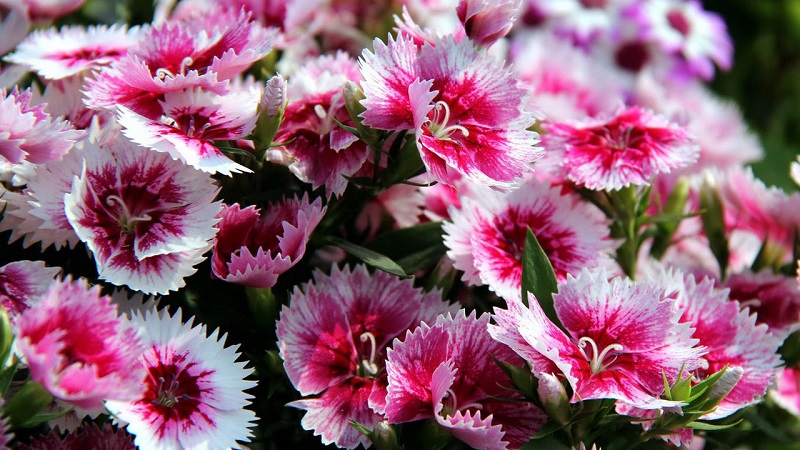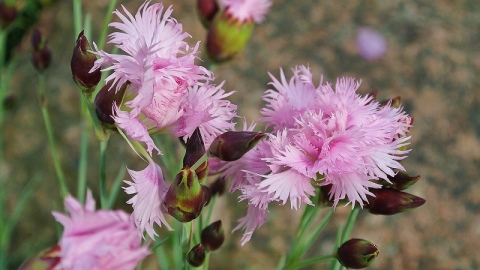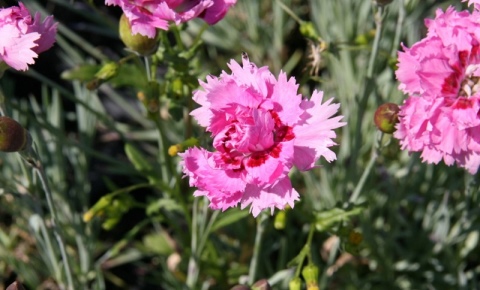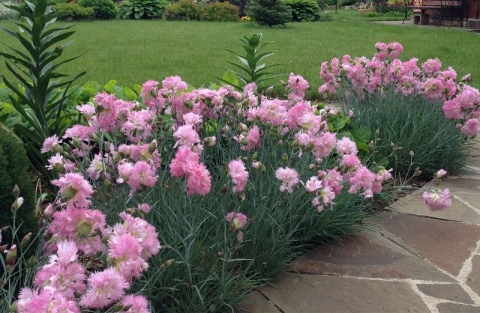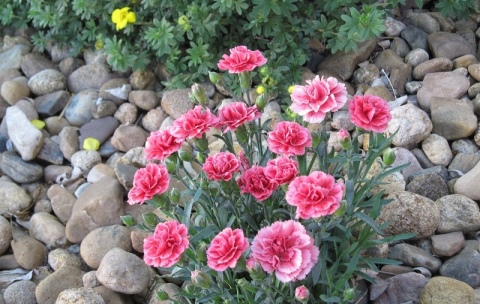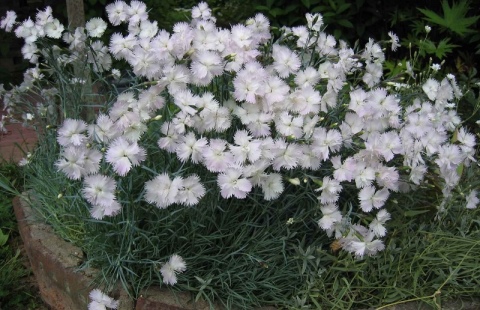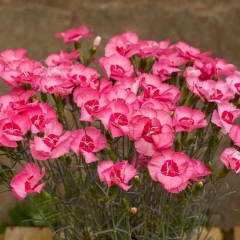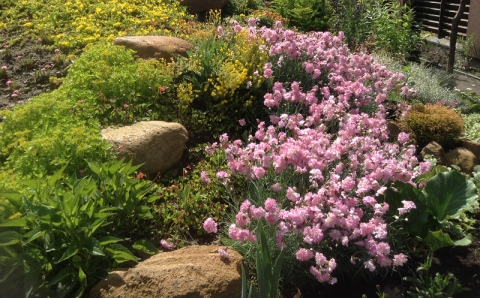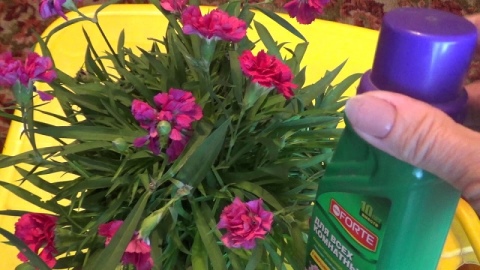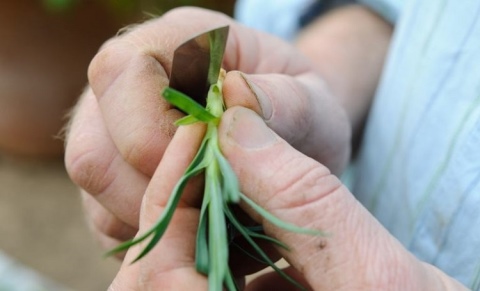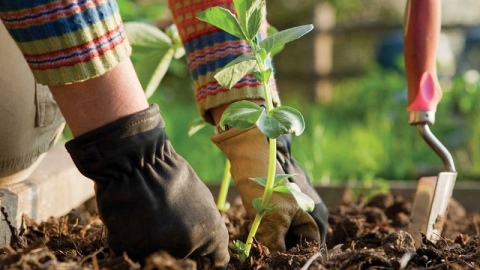Characteristics of species and varieties of cloves
Almost all types of carnations have found their place in gardens. The variety of natural species and a huge number of artificially bred varieties and hybrids allow carnation to fit into the design of any garden.
In addition to the division into annuals, biennials and perennials, different types and varieties of carnations differ in appearance. If you look at the photo of a carnation, you can see differences in the color and shape of the leaves (from light green to dark green, there are plants with a silvery-bluish tint of foliage). Stems are smooth, knotty, straight or branched, herbaceous and partially woody.
Carnation is classified:
- by plant height (low and tall varieties);
- by the timing of the beginning of flowering (early, middle, late flowering).
The most popular types and varieties of cloves
- Turkish or bearded carnation. One of the most popular varieties among gardeners. It is a biennial or perennial plant with an erect, weakly branched stem, up to 60 cm in height. Shield inflorescences are formed by small bright flowers of pink, red, purple, white, purple shades. There is a variegated color of flowers. Flowering begins in mid-summer and lasts for about a month. The plant is used not only for flower beds, alpine slides and mixborders, but also for cutting. In culture, Turkish carnation has been cultivated since the end of the 16th century, and still has not lost its popularity. This is a very unpretentious and beautiful flower. Some popular varieties of Turkish carnations: Surprise (double flowers), Ugolyok (burgundy, almost black flowers). And also: Pink Beauty, Scarlet Beauty, White Queen, Holland.
- Garden or Dutch carnation. A perennial plant that forms lush, rapidly growing bushes. The stems of the Dutch carnation grow up to 80 cm, crowned with large (up to 8 - 10 cm) flowers, often collected in inflorescences. The color of the petals is very diverse. Long-term flowering, year-round in potting conditions. About 200 varieties of garden carnations are known, which can be divided into groups: Grenadine - a carnation with pink or red monochromatic flowers (varieties - Rosakenigen, Gloria, Lady in Black, Carrot King); Shabo - a carnation with large double flowers of various shades (varieties - La France, Aurora, King of Fire, Marie Shabo); dwarf or undersized - a group of varieties up to 25 cm high, grown in room culture (varieties - White Ladies, Spring Beauty).
- Chinese carnation. A perennial plant with a height of knotty stems up to 50 cm. Chinese carnation is widespread throughout the world, due to its unpretentiousness and decorative effect. It has large, single, or flowers collected in corymbose inflorescences. Dwarf varieties grow well in pots at home. Varieties popular with gardeners: Snezhana, Imperial, Black and white troubadours, hybrid carnation Diana).
- Clove herb. Winter-hardy perennial type of carnation, up to 40 cm high. Forms loose sods of herbaceous thin stems with small single flowers or shield inflorescences. It is grown everywhere as a curb crop, a plant of alpine hills and rockeries. Varieties: Scented carpet (red flowers), Arctic Fire (white flowers with a red ring). Other types of carnations are used in gardens, flower beds, parks and container plantings: alpine, pinnate, field, lush, Alvud, Fischer.
Use in landscape design
Any representative of the flora can envy the universal use of cloves. It enters the flowering phase in June-July and transforms the landscape with its decorative effect for two seasons. Therefore, it is used for most types of compositions. The first wave of fame falls on the arrangement of flower beds, gardens and mixborders.
She decorates not only individual sites, but also city parks.A gorgeous beauty at the base of an alpine slide feels comfortable. It successfully grows around stones of different sizes and brings freshness and picturesque colors to the stone composition. For the same reason, it is planted on emerald lawns.
Island or bouquet planting can be monochromatic or consisting of a pair of varieties of different colors. Carnation works well with many plants of various heights, colors or configurations. Pansies, various ornamental grasses and cereals, asters, Lyubertsy and many others are considered especially suitable “neighbors”.
You can choose a harmonious combination with the queen of the garden - a rose. Of course, the carnation cannot compete with her. However, it perfectly complements the composition by playing the role of a beautiful background. In order to highlight the size and color of the rose, small varieties are chosen, with a contrasting shade.
It is often used as a curb "resident". She skillfully frames tracks from any natural raw materials:
- stone;
- wood;
- pebbles and others.
Perennial Chinese carnation: planting and care, photos of various varieties, growing from seeds and use in landscape design - all this is important information for those who want to plant an exotic beauty on their site.
Growing a perennial Chinese carnation in the country will not be difficult even for a novice florist. The main thing to remember is that this plant prefers sunny areas and needs pruning after flowering, does not tolerate fresh manure and excess moisture. Follow the recommendations for carnation care, and your flower bed will be filled with bright colors of fragrant flowers.
How to care for
Garden carnation is an unpretentious and persistent plant, but in order to get abundant and long flowering year after year, you need to take into account its characteristics. Top tips for planting and grooming include:
- When choosing a place for planting, give preference to sunny areas. In partial shade, the flowers will not be rich.
- Avoid low-lying areas where water stagnates. Plants do not tolerate excess moisture.
- It is required to establish systematic watering.
- Seasonal maintenance includes: loosening the soil, removing weeds and removing dead buds.
- Tall species are tied to a support in order to prevent stem breakage in strong winds.
Proper watering
Garden perennial carnation loves constant but moderate watering, about one plant requires 0.5 liters of water. The plant is able to survive a slight drought, but the excess and stagnation of moisture is destructive for it.
Watering is carried out in the evening, trying to deflect the flow of water directly under the root. It is necessary to loosen the ground after any watering, at once removing weeds.
Fertilization
In the first year of growth, nitrogen-containing fertilizers, such as humus and urea, can be used as top dressing to enhance the green mass.
From the second year of growing season, garden carnations are fed according to the following scheme:
- Early spring - urea is introduced in a dried form and embedded in the ground;
- Budding - systemic fertilizers for flowering plants "Kemira", "Master", "Universal", "Pokon", in addition, you can use nitroammophoska and superphosphate (20 g per 10 l of water);
- Flowering - complex mineral fertilizers.
Protection against diseases and pests
When breeding carnations from seeds, you can meet with various viral diseases that affect not only the leaves, but also the root system.
The most common diseases include:
- Fusarium wilting. The main symptoms are as follows: the flower stems gradually acquire a dirty yellow color, and the planting tissues begin to fade. As a result, the plant disappears. There is no way to combat such a disease, you can only make prevention and treat the plant with such a substance as “Baktofit”.
- Viral infections are found in the form of inhibited growth and discoloration of the leaves.Unhealthy plants must be eliminated immediately so that the virus does not spread to other flowers. The tool with which you removed the plant must be effectively treated in order to avoid further infestations.
- White rot. You can fight this disease with the help of chemicals. The first symptoms of the disease are the appearance of brown spots on the plant.
- Brown rot indicates that the air humidity is quite high. To eliminate such a disease, the proper chemicals must be used.
- Rust appears in the form of yellow pads, which eventually turn brown. To combat rust, professional gardeners advise using Bordeaux acid.
When breeding a mix of carnations from seedlings or seeds, you can meet the following pests:
- Spider mite. This insect starts in dry air and high temperatures. A similar mite wraps its own web around the plant, reducing the plant's immunity. To combat such an insect, it is allowed to use chemicals such as Fitoverm or Iskra.
- Thrips. These pests deform the stem. Thrips start if the air humidity is high enough.
Preparing for winter
In our weather conditions, the Chinese perennial carnation overwinters quite well. In late autumn, we cut the stems of the flower at a height of about 10 cm above the ground. Some do not insulate the bushes of this plant at all in the country. To prevent freezing of carnations in powerful frosts, cover it with peat, sawdust or fallen leaves. With the arrival of spring, we remove the cover.
Transfer
Since the carnation is grown as an annual, no transplant is required. Therefore, we can only talk here about the methods of reproduction of the variety you like.
The main and most common way of carnation propagation is sowing by seeds. To do this, you need to do the following:
- pour water into the hole (when sowing dry seeds);
- place the planting material there, the embedding depth is no more than 1 cm;
- sprinkle with soil;
- moisten the soil using a spray bottle;
- cover the container with a polyethylene cap.
Important! The film should be opened a little several times a week - this will allow the sprouts to gain access to oxygen. The soil in the greenhouse must be periodically moistened until shoots appear.
This will happen in about 2 weeks.
A month later, young plants should be planted in pots, at a distance of at least 5 cm from each other. For propagation of carnations, you can also use the cuttings method. Cuttings are taken only after flowering.

Winter feeding and caring for indoor flowers For the classical formation and development of indoor flowers, it is necessary to regularly feed them. V…
They are placed in a container filled with a light substrate, covered with a polyethylene cap, glass jar or plastic cup. Do not clean the shelter within a month, it is only necessary to periodically ventilate the greenhouse.
You can use another method: place the stalk in a container with water and leave until the roots appear. Water needs to be added periodically.
Note! The most favorable time for sowing carnation seeds is considered the beginning of spring (March-April)
Before buying seed, you should pay attention to the year of harvest. The seeds that were obtained from last year's flower have the best germination.
Some secrets:
- Seed material need not be pre-soaked. It is enough just to place the seeds in a pot with soil, deepen them by 2-3 mm and spray them well with water from a spray bottle.
- For seedlings, it is better to choose the brightest place. Then the emergence of seedlings can be expected in a week.
- They begin to form the future bush after five real leaves appear. To do this, pinch the side shoots, as well as the top of the plant.Pinching properly will produce a more lush bloom and a plush crown.
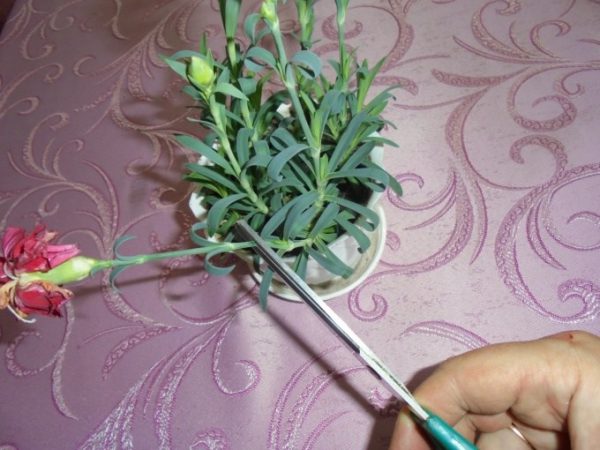
The indoor beauty will begin to bloom already 60-90 days after planting. The bushes planted in early spring will delight the owner with their beauty throughout the summer. Sowing seeds can be done in the fall, but then flowering will need to wait until next year.
For reference! For the reproduction of perennial and biennial species of carnation, methods of transplanting cuttings and dividing the bush are also used.
With any method of planting, it must be remembered that a young plant does not tolerate excessive deepening into the soil. Plantings need timely watering, and it is recommended to add sand to the soil to prevent moisture stagnation and root decay.
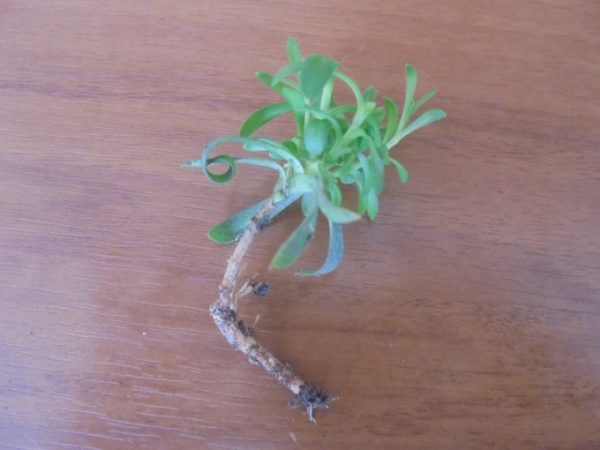
Growing seedlings
It is customary to plant Chinese carnations at home when you need to prepare seedlings in advance. Experienced agricultural technicians recommend sowing seeds from January if early spring is observed in the region. In the middle lane for planting, it is better to choose the end of February. Any wide container will do for sowing.
The preparation of the container and the planting of seeds takes place in the following order:
- laying on the bottom of the drainage layer, excluding stagnant water;
- filling with a substrate - a ready-made mixture for seedlings or a composition based on garden soil, sand and vermiculite is suitable;
- distribution of seeds - they need to be evenly scattered over the surface of the soil without deepening, sprinkled on top with vermiculite, which promotes germination;
- moistening the soil - it is better to spray it from a spray bottle with water at room temperature.
The optimal temperature regime for this period should be +20 degrees, it is important to maintain good humidity, but without overflow. After the sprouts appear, it is worth moving the seedlings to a cooler place, maintaining the ambient temperature in the range of + 15– + 17 degrees Celsius, which will avoid excessive stretching of the sprouts
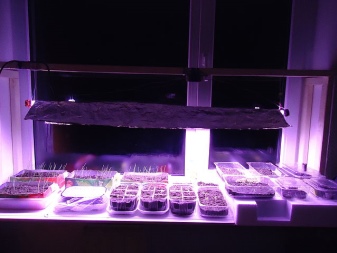
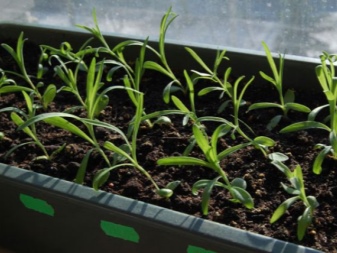
Plants are transplanted into separate containers after 2 leaves appear. In these containers, they are cultivated until they are planted in the ground. To ensure proper development, it is imperative to pinch the plants at the top, leaving only 4 lower leaves, and cutting off the rest with carefully disinfected scissors. Thus, the bush will increase the mass of lateral shoots, it will turn out to be denser and more branched.
Seedlings can be sent to open ground only after a series of return frosts has passed. Depending on the region, this period falls on May or early June, by which time the Chinese carnation can pick up buds and get ready to bloom. 7 days before transplanting, you need to start hardening by placing the seedlings outdoors during the daytime.
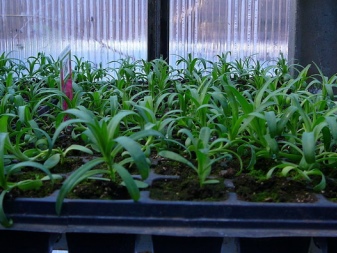

Diseases and pests
One of the most common causes of fungal infections is waterlogging of the soil. To protect the site from fungal diseases, preventive measures must be taken. At the beginning and in the middle of the growing season, the stems and leaves of cloves should be sprayed with fungicidal preparations.
Let's consider in more detail mycoses.
- Alternaria This disease is a fungal infection of leaves and flowers that wilt and fall off. The appearance on the stems and leaves of brown spots with a dark bloom should serve as a signal that the plant urgently needs treatment.
- Fusarium. This disease often goes away unnoticed, manifested by a slowdown in flower growth.
- Rust. It is often passed on from other plants. Signs of the disease are brown spots on the stem and leaves of the plant. The diseased parts should be removed, the cloves should be treated with Actellik, Aktara and Mospilan fungicides.
If we consider viroses, it is worth highlighting several diseases.
- Mosaic. Symptoms are small streaks or specks that dry out the leaf over time.On flowers with red and pink petals, it appears as thin light stripes.
- Mottling. If some of the buds do not bloom during the flowering period, and chlorine spots appear on young shoots, most likely the plant is infected. Over time, the flower dries up completely and dies.
- Bushiness. Strong branching and a large number of young shoots can be a sign of illness. Growth slows down, there are no buds.
It is worth paying attention to the control measures
- Pruning and culling of affected plants. Destruction of vector pests and weeds. To destroy them, it is necessary to treat the soil and plants with insecticides. Gardeners prefer the use of folk remedies such as infusions of onion peels or potato tops. You can also plant calendula or mint between the rows.
- Particularly dangerous are the scoop, thrips and rootworm nematode. If the plant is attacked by a nematode, it must be immediately dug up and burned. The soil on the site of the sick flower will need to be additionally treated with boiling water, and then with any insecticide.
How to grow herbal cloves from seeds
Seeds can be sown in a prepared bed when the air temperature reaches +15 degrees. Planting seeds directly into a flower bed has several disadvantages.
- Grass carnation seeds are very small (less than 1 mm), and it is difficult to sow them evenly into the grooves.
- When sprouts appear in the garden, they will need to be thinned out. Thus, much more seeds will be consumed than when growing seedlings.
- Seeds in a garden bed, due to the spring fluctuations in day and night temperatures, sprout slower than weeds. The latter may prevent the seeds from sprouting.
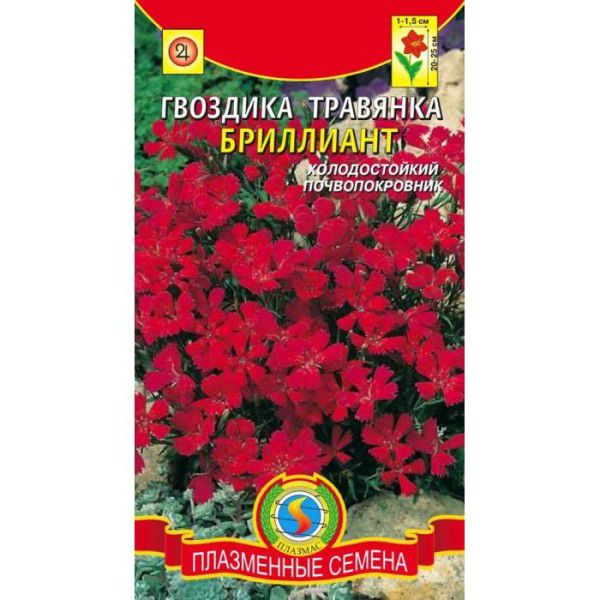
Carnation herbal Diamond - seeds
For seedlings, fertilized garden soil is needed, to which peat and sand are added. Growing herbal clove includes the following steps.
Step 1. Pour soil into a box or container. It can be pre-baked in the oven to destroy the two-tailed and other insects, as well as to kill the fungus.

The soil is poured into the container
Step 2. The soil is watered so that it is moist throughout the entire volume of the box.
Step 3. Seeds are sown in two ways. You can cut off the edge of the bag and scatter the seeds evenly over the surface of the ground. The second method is preferable: the seeds are poured onto a small sheet of paper and sown, slightly shaking the leaf over the planting box.

Sowing seeds
Step 4. Sprinkle the seeds with a layer of earth. The thickness of the soil should be from 1.5 to 3 mm, but not more. After that, the ground is well sprayed with water.
Step 5. The box is closed with a transparent lid (or tightened with plastic wrap) and placed on the windowsill.

The container is covered with a lid
Step 6. Watering the seedlings is done as needed.
Step 7. Seeds of carnation of herbaceous plant sprout densely, therefore, the sprouts that are 2-3 cm long are thinned out, leaving the required number of seedlings. Sprouts appear in 9-14 days.
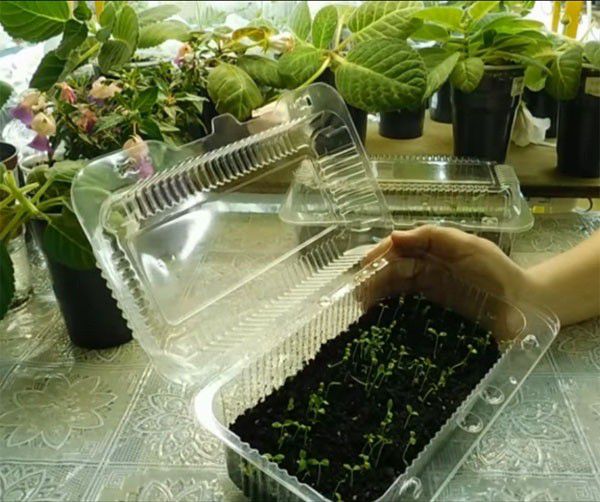
Carnation shoots
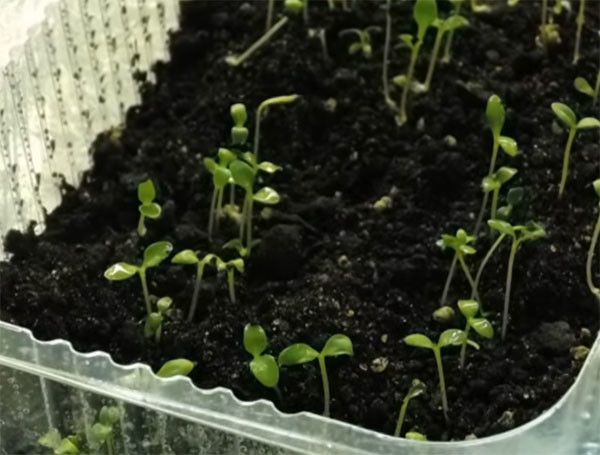
Another photo of seedlings
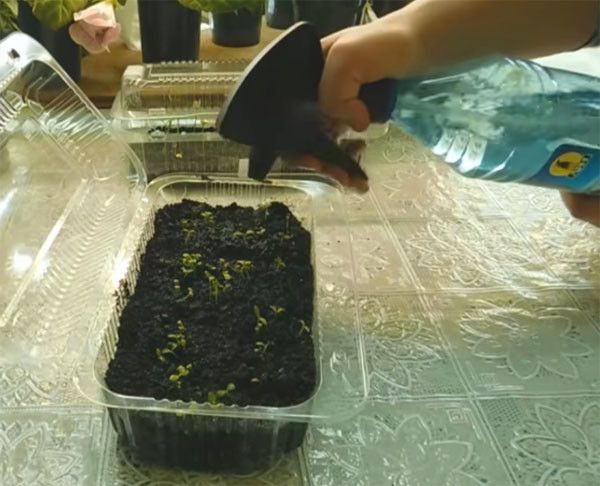
Seedlings are sprayed with a spray bottle
Step 9. As necessary, sand, ash, mineral fertilizers or natural organic matter are added to the soil. The flower grower needs to achieve a slightly alkaline or neutral soil composition.
Step 10. The earth is dug deeply and flower beds are formed.
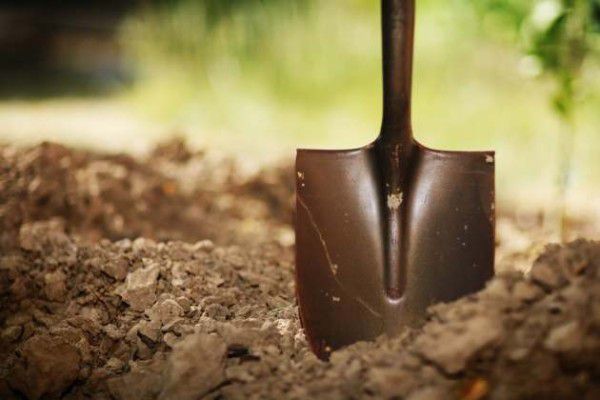
The earth needs to be dug deep
Step 11. On the flower beds, holes or grooves are made, water is poured into them and sprouts are planted from the container. The distance between the seedlings depends on the type of herb carnation. Seed producers indicate on the pack at what distance the plants should be planted (15-40 cm).
Step 12
The flowerbed is carefully watered. If the weather is hot, the space between the shoots can be covered with grass to retain moisture (do mulching)
Step 13. So that young juicy seedlings are not destroyed by rodents, the flower beds around the perimeter can be fenced with spruce branches or any thorny shrub. The lapnik can be removed when the flowers grow up.
Step 14. In the following days, the flower beds are watered moderately as the soil dries up.
Step 15.Carnation grass creates a continuous lawn, the bushes do not need to be formed. The flowerbed is weeded as the weeds grow.
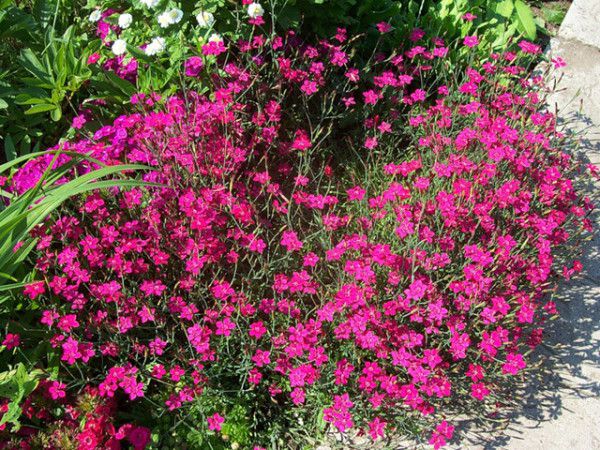
Carnation deltoid, or herbal carnation
Step 16. For the winter, flower beds and beds are not covered, breeding varieties winter well.
Fertilizers can be applied to the soil before flowering. They are essential for the normal development and flowering of carnations.
Table. Fertilizers for slightly alkaline and neutral soils (for growing herbal cloves).
| Fertilizers | Quantity per 1 sq. m | How do they make |
|---|---|---|
| Humus or compost | 5-7 kg | Spread on the ground before digging |
| Wood ash | 200 g | Spread on the ground before digging |
| Potassium sulphate | 1 teaspoon | Dilute in 10 liters of water and water the soil |
| Nitrofoska | 1 teaspoon | Dilute in 10 liters of water and water the soil |
| Fertilizers for flowering plants Flora Bloom, Eticco, GO BioBud, flowering stimulator Hesy Boots and others) | According to the instructions for the tool | According to the instructions for the product, before flowering |
Influence of different doses of fertilizers on the growth and decorativeness of carnations

